Historical Timeline
Have something to add?
Is there something you'd like to see included in this timeline? Please email your contribution to brandeis75@brandeis.edu.
From the moment Brandeis University opened its doors in 1948, it was a university on the move.
A bold experiment set in motion by the American Jewish community, created to redress the antisemitism and bigotry then prevalent at prestigious American universities, Brandeis drew vitality and direction from its foundational values: a reverence for learning, a passion for critical thinking and questioning, and a desire to help repair the world.
In just 75 years, Brandeis has become a beacon of aspiration and accomplishment in the higher-education landscape. Ever enterprising and forward-looking, it is forging a path to an even brighter future.
Unless otherwise noted, archival photos courtesy of Robert D. Farber University Archives and Special Collections Department.
1940s | 1950s | 1960s | 1970s | 1980s |1990s | 2000s | 2010s | 2020s
1948

- Abram L. Sachar, H’68, chairman of the National Hillel Commission, is chosen to serve as the university's first president. At his installation in October, he says, "America is not a melting pot at all; it is a symphony. The precious groups that have come to these shores must not disappear into an assimilative cauldron. They must retain their uniqueness, which has come out of their special heritage."
- On Oct. 11, Brandeis begins its first academic year with 107 students and 13 instructors. The campus consists of eight buildings on 100 acres. Three divisions — language, literature, and the arts; social sciences; and mathematics and the natural sciences — house 20 academic departments. Course titles include 20th-Century Hebrew Verse, Evolution of Economic Thought, Principles of Ethics, Child Psychology, Zoology of Invertebrates, and Advanced Calculus I and II. Tuition is $500 per year.
- Brandeis Hillel is founded. President Sachar notes the university must serve as "an influential center of Jewish learning and communal responsibility."
- Brandeis University National Women's Committee (now known as the Brandeis National Committee) is founded to help establish and maintain a library for the university. To honor BUNWC's eight founding members, Boston attorney and philanthropist George Alpert pens a tribute:
The ladies of Boston and neighboring towns,
With an impulse that came from the heart,
Decided to furnish essential books
To fill the library's shelves and nooks
With ten thousand volumes to start.
1949

- Former first lady Eleanor Roosevelt, H’54, joins the university's Board of Trustees.
- The Justice newspaper is founded ("Exams Climax First Brandeis Term" is the banner headline in its debut issue). During its first years, the paper is written and distributed by the university's administration; later it becomes Brandeis leading student newspaper.
- Saarinen, Saarinen & Associates is hired to create the university's first master plan. Eero Saarinen, a world-famous architect, envisions a "seat of learning" at the center of campus, surrounded by residential quadrangles in the modernist style. After the plan is criticized for being too rectilinear, Saarinen revises it slightly by altering the harsh angles of the quads. By 1952, architectural projects are being awarded to other firms, and Saarinen's original plan — except for the surrounding quadrangles — is abandoned.
- The university's first Convocation honors African American political scientist and future Nobel Peace Prize recipient Ralph Bunche, H’60, and Israeli diplomat/politician Abba Eban, H’58.
1950

- Construction of on-campus dormitories begins, with the goal of allowing 90% of the university's students to live on campus. Architect Eero Saarinen, Brandeis' first master planner, builds Ridgewood Quad (completed in 1950) and the Sherman Student Center in Hamilton Quad (later known as Massell Quad) (completed in 1952).
- Eleanor Roosevelt, H’54, speaks at Convocation. "It is indeed a sign of faith that so many people have gathered here to celebrate and show their interest in a university that is scarcely 2 years old," she says. "Those who come here to study have a very great gift, because they come to a university that is founded on the principles of democracy."
1951

- The Massachusetts legislature authorizes Brandeis to award advanced and honorary degrees.
- Brandeis' first varsity football game, played at home, results in a loss to the University of New Hampshire.
- Israeli Prime Minister David Ben-Gurion, H’60, visits campus as a special guest at a student-sponsored convocation.
- Boston patron of contemporary art Louis Schapiro establishes the university's first permanent art collection by donating almost 200 paintings.
- Composer/conductor Leonard Bernstein, H’59, joins the university as a member of the music faculty, a position he holds until 1956.
1952

- Brandeis forms its own NAACP chapter. It's advised by historian/future Pulitzer Prize winner Leonard Levy, H’87, and founded, in part, by one of Brandeis' first black graduates, Herman Hemingway ’53, H’21. In March, the group hosts African American poet and social activist Langston Hughes.
- The university graduates its first class, with 101 students receiving undergraduate degrees. Eleanor Roosevelt speaks at Commencement, recommending that graduates consider spending time abroad: "I want to urge that you go with the spirit of willingness to give and, at the same time, willingness to learn."
- The first Festival of the Creative Arts is held on campus in the newly opened Ullman Amphitheater, with Leonard Bernstein conducting the world premiere of his opera "Trouble in Tahiti."
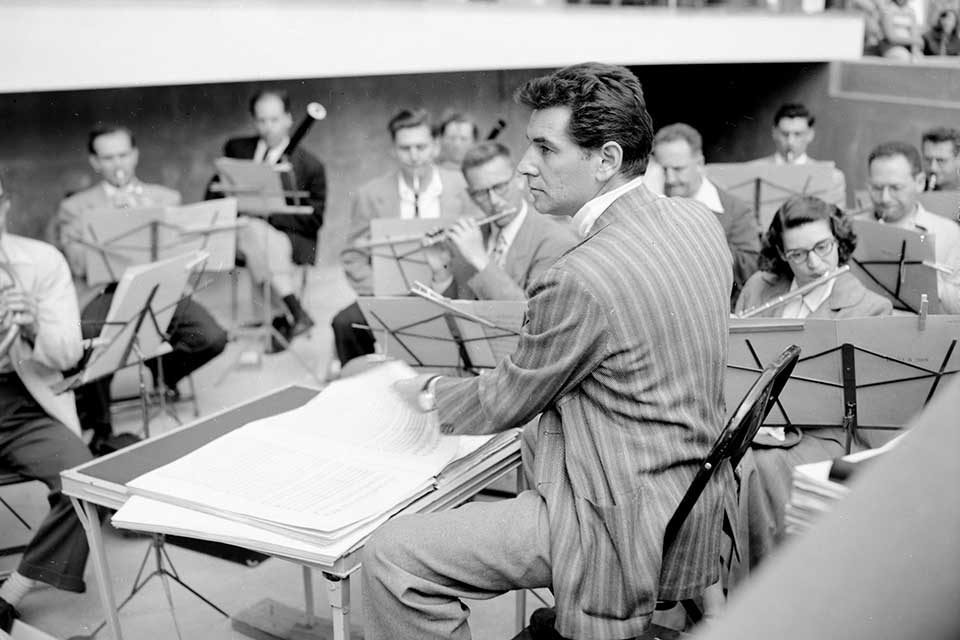

1953

- The Graduate School of Arts and Sciences is established.
- The Department of Near Eastern and Judaic Studies, one of the first academic programs in Jewish studies at an American university, is created, with philosopher Simon Rawidowicz serving as founding chair.
- Brandeis hires the architectural firm Harrison & Abramovitz to further develop the university's master plan. Max Abramovitz, a prominent New York architect, oversees the planning for the next 30 years and designs the vast majority of buildings on campus, including the Slosberg Music Center and the Rose Art Museum.
- More than 100 members of the NAACP"s Brandeis chapter work with other civic groups to sponsor an athletic and cultural program for Roxbury and Dorchester high school students, and help students of color gain admission to New England prep schools.
1954

- Brandeis is fully accredited by the New England Association of Colleges and Secondary Schools.
- Construction begins on an interfaith center, designed by Harrison & Abramovitz, consisting of separate Jewish, Protestant, and Roman Catholic chapels. President Abram Sachar, H’68, describes the idea of the three chapels as the "ideal interfaith experiment, since Brandeis is the first university to provide facilities for groups of lesser number."
1955

- Brandeis' three chapels are dedicated. The Jewish chapel is named in memory of Mendel and Leah Berlin, parents of prominent Boston surgeon David D. Berlin; the Protestant chapel is named in memory of former Supreme Court Justice John Marshall Harlan; and the Roman Catholic chapel is named Bethlehem.
- Thousands of members of the Brandeis University National Women's Committee meet in small groups in homes, public libraries, and community centers to study everything from Shakespeare to American Jewish humor, using close to 100 syllabi and discussion guides written by Brandeis faculty.
- Students oppose a planned screening of the notoriously racist film "The Birth of a Nation." After a contentious meeting, the Student Council votes not to show the film.
1956

- Brandeis receives a $1 million donation from New York industrialist Jacob A. Goldfarb, H’63, to build a library.
- Robert Berks' statue of Louis Brandeis is unveiled in Fellows Garden and instantly becomes a campus landmark. Berks' wife, Dorothy, who had been the justice's personal assistant for 39 years, modeled for her husband (wearing Brandeis' actual robes) during the statue's creation.
- The Rev. Martin Luther King Jr. makes the first of three visits to campus.
1957

- The Slosberg Music Center opens as Brandeis' first home for the arts.
- Composer Aaron Copland, H’57, conducts an orchestra at a Festival of the Creative Arts event.
- Martin Luther King Jr. makes his second campus visit, delivering a speech titled "Justice Without Violence." It addresses the segregation crisis in the South as well as King's theory and practice of nonviolent resistance.
Listen to "Justice Without Violence"
1958
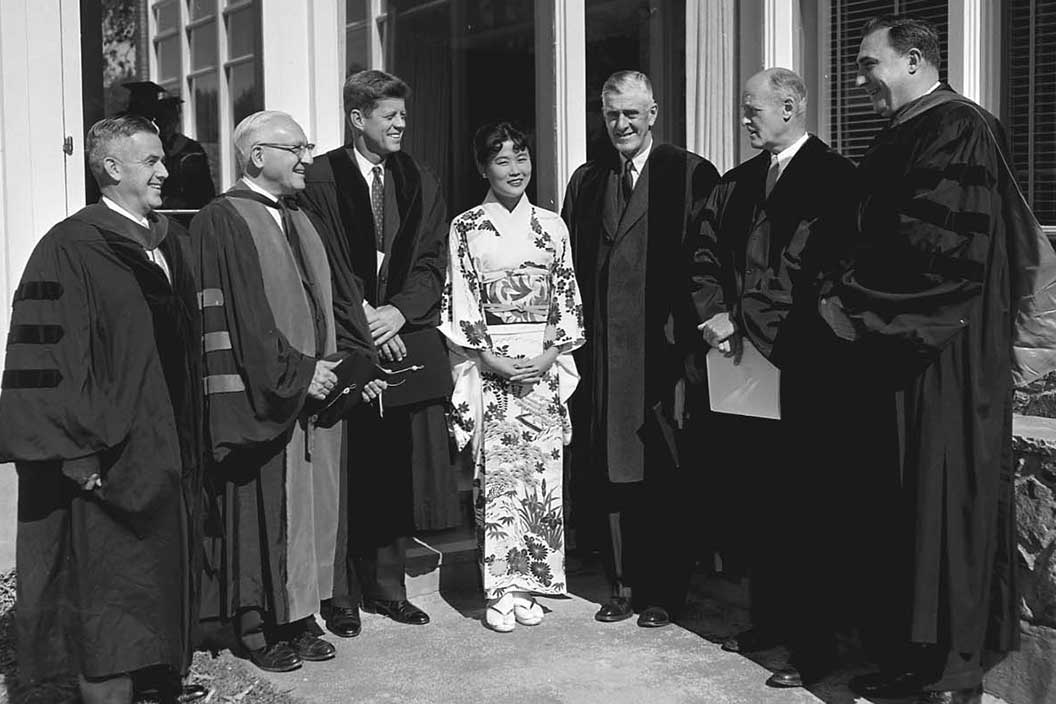
- The Wien International Scholarship Program is established to bring international undergraduate students to Brandeis. John F. Kennedy, H’58, then a U.S. senator, speaks at the dedication ceremony, where he receives an honorary degree.
1959

- The Florence G. Heller Graduate School for Advanced Studies in Social Welfare, later to become the Heller School for Social Policy and Management, is founded.
- The Jacob A. and Bertha Goldfarb Library opens in time for the 1959-60 academic year, holding a collection of 156,360 volumes.
- Eleanor Roosevelt becomes a visiting lecturer in international relations, a post she holds until 1962.
- Writer James Baldwin visits campus, delivering a lecture on "The Problem of Evil in American Literature."
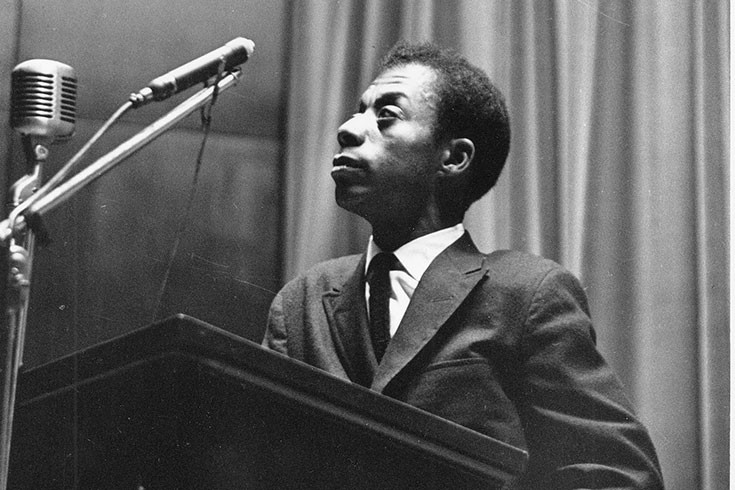

The Florence G. Heller Graduate School for Advanced Studies in Social Welfare, later to become the Heller School for Social Policy and Management
1960

- Hours after announcing his candidacy for the U.S. presidency on Jan. 2, Sen. John F. Kennedy, H’58, makes his second trip to the Brandeis campus for an interview with former first lady Eleanor Roosevelt, H’54. (Roosevelt was the host of "Prospects of Mankind," a public television series on domestic and international affairs that was taped at Brandeis.)
- Brandeis students brave a March cold snap to picket a Boston-area Woolworth's. The protest comes a month after four African American college students hold a sit-in at a segregated Woolworth's lunch counter in Greensboro, North Carolina.
- The campus construction boom continues as the Social Science Center, Schwartz Hall, the Lemberg Children's Center, and the North Quad open.
1961

- The Rose Art Museum — led by founding director Sam Hunter, former curator of painting at the Museum of Modern Art — opens to the public.
- The Heller School graduates its first class of students.
- The Jacob Hiatt Institute in Israel, Brandeis' first study-abroad program, opens with 13 students in attendance. By the time it closes in 1983, it has educated 600 students from 150 U.S. colleges.
- A New York Times profile of Brandeis, headlined "Case History of an Academic Prodigy," notes, "The atmosphere at Brandeis combines impatience, intellectual restlessness, and pride seasoned by a friendly family spirit."
- Brandeis wins Phi Beta Kappa accreditation only 13 years after its founding. At the convocation celebrating the accomplishment, U.S. ambassador to the United Nations Adlai Stevenson, H’61, wryly comments, "My own distinguished alma mater, Princeton, waited 123 years to be similarly recognized."
- Cholmondeley's opens in Usen Castle. The student-run coffeehouse is named after university photographer Ralph Norman's pudgy black-and-tan coonhound. More than a decade later, Marta Kauffman ’78, H’20, and David Crane ’79 draw on their affection for the popular hangout when they create the TV series "Friends."
1962

- Donor Leon Mnuchin and his wife, Harriet Gevirtz-Mnuchin, donate $50,000 to the Rose Art Museum. Spending no more than $5,000 on a single piece, director Sam Hunter uses the money to buy Pop Art works by Andy Warhol, Robert Rauschenberg, Roy Lichtenstein, and other artists, long before they become iconic.
- The Saturday Review publishes an in-depth profile of Brandeis, titled "A Young University in a Hurry." In it, President Abram Sachar, H’68, explains the university's "pressure cooker approach" to achieving greatness.
- On Oct. 2, The Justice publishes an exclusive article by civil rights activist James Meredith about "the Southern Negro," which had been written as a letter to student Peter Osnos ’64 the previous March. The article appears the day before Meredith breaks the color ban at the racially segregated University of Mississippi.
1963

- Brandeis installs an IBM 1620 computer (with a memory of about 7K) for faculty research and student coursework in science and mathematics.
- The Feb. 3 issue of The Justice announces the Brandeis chapter of Students for a Democratic Society distributed its first newsletter the previous Saturday. The newsletter encourages students to become politically active.
- The Rev. Martin Luther King Jr. makes the third of his three visits to campus to lecture on nonviolence and racism.
- In May, Bob Dylan plays at the first Brandeis Folk Festival. The performance is recorded, unbeknownst to Dylan. More than a decade later, the tape is discovered in the basement of a Rolling Stone magazine co-founder.
- The Justice devotes most of its Nov. 26 issue to President John F. Kennedy's assassination.
1964

- In early March, President Sachar "decree[s] that henceforth, when students entertained members of the opposite sex in their rooms, the doors must be ajar," reports The Justice. Although parietals — the rules governing socializing between the sexes in dorms — have been in place since the university's founding, Sachar's edict causes an uproar among students.
- "One-Dimensional Man," a book by politics professor and Marxist philosopher Herbert Marcuse, is published. The book becomes a lightning rod for rebellion, student movements, and the New Left, as well as a staple of college syllabi for decades to come.
- The physics department offers the university's first computer course, Numerical Methods and Computer Programming, covering algebraic and differential equations, statistical analysis, and linear programming.
- Joseph Heller donates the original manuscript of his novel "Catch-22" (1961) to Brandeis. Written in longhand on yellow legal pads, the manuscript offers a fascinating look at the revisions Heller made as he wrote.
1965

- The Gerstenzang Science Quadrangle — named for prominent donor Leo Gerstenzang, inventor of the Q-Tip — opens.
- About two dozen Brandeis students travel to Columbia, South Carolina, to canvass for voter registration, successfully registering over 2,000 voters.
- Indira Gandhi visits campus on Feb. 4, a year before she is elected India's prime minister.
- Four Brandeisians join the civil rights march from Selma to Montgomery, Alabama: American studies professor Lawrence Fuchs, Fran Forman ’67, Steve Herman ’68, and Peter Malmgreen ’67.
- Theater luminaries Sir John Gielgud, H’65; Alfred Lunt and Lynn Fontanne, both H’65; Lillian Hellman, H’55; George Balanchine, H’65; and Richard Rodgers, H’65, dedicate the Spingold Theater Center. The center's inaugural production is Ben Jonson's comedy "Volpone."
- Norm Levine becomes head coach of track and cross-country, a position he'll hold for 30 years. He coaches 51 conference, regional, and national champions, and 159 All-Americans, and clinches the 1983 men's cross-country title.
- The Spingold Theater Center's Joan Crawford Dance Studio is dedicated in honor of the actress, who supported the arts at Brandeis. In 1967, Crawford becomes a Brandeis University fellow.
- The Rabb Graduate Center opens.
1966
- The Waltham Group, a network of student-run volunteer programs, is founded. Today, it remains the largest student group on campus, organizing community food drives, tutoring and Big Brother/Big Sister programs, elder services, and more.
- The Lown School of Near Eastern and Judaic Studies is established.
1967

- In early February, amid growing opposition to the Vietnam War, the university's Ad Hoc Committee for Victims of Vietnam oversees on-campus participation in a nationwide fast to protest the war.
- Brandeis recruits former Boston Celtics star K.C. Jones to coach the varsity men's basketball team. He leads the team for three seasons, chalking up a 36-33 record. Later in his career, as the Boston Celtics head coach, he earns NBA championships in 1984 and 1986.
- In October, The Justice reports the Brandeis chapter of Students for a Democratic Society is campaigning against an upcoming CIA campus-recruitment event. A university official says students may picket, but anyone "who trie[s] forcibly to stop" the event will be expelled.
- In November, The Justice publishes the results of a poll in which almost 90% of undergraduate respondents say they are opposed to the Vietnam War. More than two-thirds say they are "willing to work in opposition of the war."
1968

- Following the assassination of Martin Luther King Jr. on April 4, Brandeis holds memorial services, suspends classes for two days, and announces a day of classroom discussion. In honor of the slain leader, Brandeis establishes 10 scholarships, known today as the Dr. Martin Luther King Jr. Fellowship.
- In September, the Transitional Year Program is launched. Now known as the Myra Kraft Transitional Year Program, it uses a combination of small classes, rigorous academics, and strong academic support to prepare talented students from under-resourced high schools for a competitive college-level curriculum.
- Feminist, civil rights pioneer, and poet Pauli Murray joins the faculty and introduces courses in legal studies, Black studies, and women's studies. She teaches at Brandeis until 1973, when she leaves to become an Episcopal priest. In 2024, the U.S. Mint's American Women Quarters program will issue a quarter that includes her likeness, making her the first Black queer person to appear on U.S. currency.
- Faculty tentatively approve a proposal for a concentration in African and African American studies.
- Lawyer and civil rights advocate Morris Abram is inaugurated as the university's second president. Founding president Sachar becomes chancellor.
1969

- On Jan. 8, approximately 75 Black students occupy Ford Hall, the university's main academic building, and issue a list of 10 non-negotiable demands for better minority representation on campus. Student protesters end the occupation on Jan. 18, after the university agrees to create an African and African American studies department, one of the first in the country. The new department is officially approved on April 24.
- On Oct. 15, the Brandeis campus observes the nationwide Moratorium to End the War in Vietnam.
- The Hornstein Program in Jewish Communal Service is established.
- History professor Leonard Levy, H’87, among the earliest faculty to join Brandeis, wins the Pulitzer Prize in History for his book "Origins of the Fifth Amendment."
- Pioneering psychologist Abraham Maslow, best known for his writings on the hierarchy of needs, retires as chair of the psychology department.
1970

- "Vision & Television," one of the first art exhibitions to focus on video and television media, opens at the Rose Art Museum.
- In April, students who oppose the Vietnam War debate whether to participate in Commencement. Ultimately, they vote to proceed with the event but wear red armbands as an antiwar statement.
- In May, students and faculty help organize a national student strike to protest America's foreign policy; the Vietnam War; and the deaths at Kent State University of four young people, shot by National Guardsmen. The National Strike Information Center sets up its headquarters in Pearlman Hall. Hundreds of colleges and universities across the U.S. join the strike.
- Morris Abram resigns from the university presidency to return to his New York law practice. Charles Schottland, H’72, Heller School dean and former commissioner of the Social Security Administration, becomes Brandeis' third president.
- Massell Quad becomes the first Brandeis residence hall complex to go coed.
- The Usdan Student Center opens.
- The shell of the Ullman Amphitheater, site of the 1952 world premiere of the opera "Trouble in Tahiti," by Leonard Bernstein, H’59, is destroyed by an electrical fire. Although the amphitheater is repaired, it is demolished in 1992 because of safety concerns.
- The Rosenstiel Basic Medical Sciences Research Center — recognized today as a cutting-edge developer of imaging technologies for the study of molecular structure and dynamics — is founded.
- Three Brandeisians appear simultaneously on the FBI's 10 Most Wanted list. Angela Davis ’65, then an assistant professor of philosophy at UCLA, makes the list when guns registered in her name are used during an Aug. 7 courtroom escape attempt by three men accused of killing a Soledad Prison guard. The following month, Susan Saxe ’70 and her roommate Katherine Ann Power ’71 participate in two Boston-area robberies to get money for antiwar activities; a police officer is killed during the second of these heists.
1971

- John Kerry, a future U.S. senator and secretary of state, addresses a campus audience as a member of Vietnam Veterans Against the War.
- The Lewis S. Rosenstiel Award for Distinguished Work in Basic Medical Research is established. Recipients of the award, which include Drew Weissman ’81, GSAS MA’81, P’15, often go on to receive a Nobel Prize for their research.
- The first Jewish Arts Festival, hosted by Hillel, is held at Brandeis. Over the years, the event brings such luminaries as Elie Wiesel, H’80, to campus.
- Brandeis University Press, which today has a backlist of more than 700 titles, is founded.
- The Brandeis Asian American Students Association is established.
1972

- Grito, a Latino student organization, sponsors boycotts of campus cafeterias in solidarity with the United Farm Workers' strike against non-unionized lettuce growers.
- Charles Schottland leaves the Brandeis presidency to return to the Heller School deanship. Marver Hillel Bernstein, H’83, former dean of Princeton's Woodrow Wilson School of Public and International Affairs, is inaugurated as the university's fourth president.
- Mike Coven becomes the men's soccer coach. He leads the program for 44 years and guides nine of his teams to the NCAA tournament, scoring a DIII championship in 1976, a third-place finish in 1981, and a second-place finish in 1984.
- Jehuda Reinharz, GSAS PhD’72, H’11, earns a doctorate in modern Jewish history from Brandeis. Twenty-two years later, he becomes the university's seventh president.
- The Feldberg Computer Center is dedicated in October. It boasts a PDP-10 computer, which includes a then astonishing amount of memory: 128K. During the 1973-74 academic year, computer science is introduced as a concentration.


1973

- The Sachar International Center is dedicated.
- On the occasion of the university's 25th anniversary, President Bernstein talks to The Justice about the university's future. "To attract outstanding students and scholars, Bernstein hopes to create undergraduate programs such as legal studies, public policy analysis, consumer protection, environmental studies, as well as to offer academic options related to vocational interests," the paper reports.
- The Stein ("an appropriately Jewish name" for the campus watering hole, The Justice notes approvingly) serves its first foamy pint.
1974

- A campus Holocaust memorial, outside the Berlin Chapel, is dedicated. It includes sculptor Nathan Rapaport's portrayal of a stunned, suffering Job, his face turned to the sky.
- Aerosmith plays Usdan's Levin Ballroom.
- Rock critic Jon Landau ’68, H’19, sees Bruce Springsteen perform at the Harvard Square Theater, in Cambridge, Massachusetts, and writes a review declaring him "rock and roll future." In 1975, Landau co-produces Springsteen's album "Born to Run." In 1978, he becomes the singer's manager.
1975

- Foster Biomedical Research Laboratories is established, expanding campus facilities for basic research in biology, biochemistry, and biomedicine.
- Thomas Friedman ’75, H’88, now a New York Times Op-Ed columnist and the winner of three Pulitzer Prizes, writes a 162-page senior thesis titled "Egypt: Crises in Revolution."
- Michael Sandel ’75, H’00, is named the university's first Rhodes Scholar. Today, he teaches political philosophy at Harvard University, and a course he developed on the concept of justice has been viewed on TV and the web by tens of millions of people around the world.
- A new student group, Brandeis Gay Advocates, is formed to provide support to homosexual, lesbian, and bisexual students, and speak in behalf of the gay community.
- In November, the Rolling Thunder Revue — featuring Bob Dylan, Joni Mitchell, Joan Baez, and Roger McGuinn — appears at Shapiro Gymnasium. Concert organizers had contacted the university to see if it would be interested in hosting a "big concert with no financial risk." The catch: The concert had to be kept secret until tickets went on sale.
1976

- "A Host at Last," a history of Brandeis' founding written by former President Abram Sachar, H’68, is published.
- First-year Mitch Albom ’79 takes his first class with sociology professor Morrie Schwartz. Albom forms a close relationship with Schwartz, who serves as the focus of Albom's "Tuesdays With Morrie," a 1997 book that chronicles Schwartz's final lessons on life and death after he is diagnosed with ALS. It becomes one of the best-selling memoirs of all time.
- Faculty approve the establishment of a women's studies program.
- The men's soccer team wins the NCAA DIII national championship.
1977

- Nobel Prize-winning novelist Saul Bellow, H’74, comes to Brandeis as a visiting professor of English and American literature. During a public lecture, he discusses the expectations placed on artists in America: "It often appears that what we Americans want from our artists is suggestions for a way to be and, if possible, a beautiful way to be."
- In May, longtime university photographer Ralph Norman, H’77, then 63 and a 27-year Brandeis employee, receives an honorary degree at Commencement, the first time a staff member is so honored. "I asked for a raise, and they gave me an honorary degree," he tells The Justice. Norman spends four more years on the job, retiring in 1981.
- Angela Davis ’65 returns to campus to speak before an audience of more than 900 on the use of the criminal justice system as a tool of racist oppression.
- The first class on the topic of black women, a two-semester course called Issues for the Contemporary Black Woman, is introduced at Brandeis.
- Both the baseball team and the men's outdoor track-and-field squad are runners-up in their NCAA DIII national championships.
1978
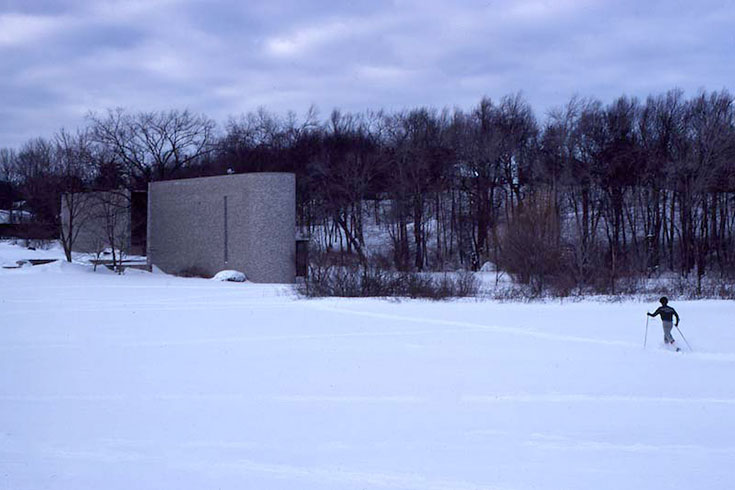
- On Feb. 6, the Blizzard of ’78 begins pummeling New England, ultimately dumping 27.1 inches of snow on the Boston area and closing campus for four days. At the same time, a severe flu outbreak sickens around 600 students (after the infirmary and other campus buildings lose power during the storm, a makeshift dispensary is set up in Deroy Hall). Students who avoid the flu head outside to go sledding or jump from rooftops into snowdrifts. Food-services staff, the buildings and grounds crew, campus police, and residence-hall personnel stay on the job throughout the blizzard and subsequent cleanup.
- In October, all four Brandeis presidents to date — Abram Sachar, H’68; Morris Abram; Charles Schottland, H’72; and Marver Bernstein, H’83 — attend a celebration of the university's 30th anniversary.
- In November, five actors from the Royal Shakespeare Company, including Ben Kingsley, visit campus for a week, participating in lectures and workshops, and performing in an anthology look at Shakespeare's lovers titled "Sigh No More, Ladies."
1979

- Usen Castle is listed on the National Register of Historic Places.
- Student counselors at the university's Student Sexuality Information Service are interviewed by Playboy for a series the magazine is doing on sexual attitudes on U.S. campuses.
- More than 80 students occupy the Bernstein-Marcus Administration Center for 72 hours to protest the university's holdings in companies doing business in apartheid-era South Africa.
1980
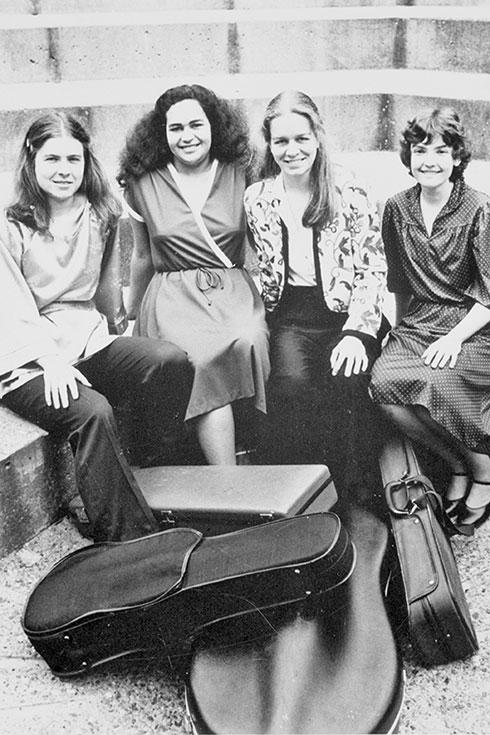
- The Lydian String Quartet is founded by violinist Robert Koff.
- The Maurice and Marilyn Cohen Center for Modern Jewish Studies and the Tauber Institute for the Study of European Jewry are established.
- Angela Davis ’65 runs for the U.S. vice presidency on the Communist Party, USA, ticket, having just turned 35, the minimum age to run for president or vice president.
- Denise Dallamora becomes head coach of the first varsity women's soccer team. She leads the program for 40 years, taking Brandeis to the postseason in 20 of those seasons, and reaching eight NCAA tournaments and 12 ECAC DIII New England tournaments.
1981
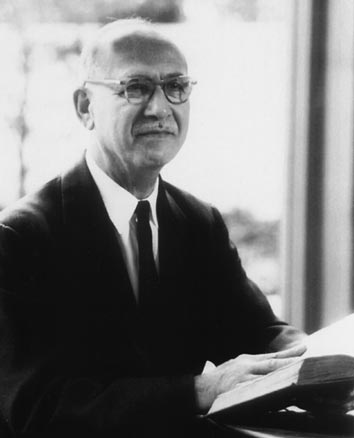
- Industrialist Bern Dibner, H’77, gives Brandeis a collection of rare texts in the history of science, valued at more than $1 million.
- The men's cross-country squad is the runner-up at the NCAA DIII national championship, and the men's soccer team makes it to the Final Four in their national tournament.
1982
- The Justice Brandeis Scholarship program, which provides merit-based scholarships, is founded.
- The family of Benjamin Michtom gives $2 million to the university to expand the computer science facilities and faculty.
- For the second straight year, the men's cross-country team is the runner-up at the NCAA DIII national championship.
- The still-active group Triskelion is founded to provide activism in behalf of and a supportive community for LGBTQ students.
1983

- A $250,000 grant from the National Women's Committee (now known as the Brandeis National Committee) to help fund card catalog automation marks the start of a multimillion-dollar technology upgrade, creating internet access for students, faculty, and staff.
- Cell biologist and former University of New Hampshire president Evelyn Handler is inaugurated as the university's fifth president, the first woman to hold the position.
- The Leonard L. Farber Library is dedicated. (Leonard Farber, H’89, later names the University Archives in memory of his late son, artist Robert D. Farber ’70.)
- The men’s cross-country team wins the NCAA DIII national championship.
- Jim Meisel ’85 establishes the Brandeis Emergency Medical Corps, now a campus-based first-response organization composed of students certified as Emergency Medical Technicians.
1984

- Jacob Hiatt, H’77, endows the Hiatt Career Development Center, which offers services ranging from internship opportunities to computer-assisted career guidance.
- Brandeis acquires the Shakespeare collection of Thomas Baldwin, a noted Shakespearean scholar, including the first edition of Shakespeare's works published in the U.S.
- The men's soccer team is a national finalist at the NCAA DIII tournament.
1985
- Brandeis is elected to the Association of American Universities, a by-invitation-only group representing 65 of the most prominent research universities in the U.S. and Canada.
- The Brandeis Student Senate asks social activist Abbie Hoffman ’59 to speak on campus. (Alyssa Sanders ’89, a student senator at the time, remembers an encounter with Hoffman before his talk: "With a misspelled shirt that read 'Brandies,' Abbie came into the Stein; pulled up a seat next to me; and, as he waited for his own food, began picking food off my plate.")
1986

- Students construct a shantytown on campus to protest apartheid and encourage Brandeis to divest from companies doing business in South Africa.
- The Department of Computer Science is launched.
- The Lemberg Program in International Economics and Finance is established.
1987
- The Board of Trustees votes to divest its portfolio of stocks of companies operating in South Africa, except those providing medical goods, humanitarian services, or media coverage.
- Brandeis joins the newly founded University Athletic Association.
- The Gordon Public Policy Center is established.
- The Hillel Theater Group is founded. The group does not perform on Friday night or Saturday, giving observant Jewish students the chance to participate. Its first performance is "Joseph and the Amazing Technicolor Dreamcoat."
- The Center for International and Comparative Studies is established.
- The campus debates the recent decision to serve pork and shellfish in Usdan Dining Hall, with some Brandeisians viewing the change as evidence the university is abandoning its Jewish identity.
1988

- The Advisory Committee on Students of Color makes recommendations to improve campus life, including the creation of an intercultural center. The Brandeis Intercultural Center is founded in 1992.
- Noel Occomy ’89 wins the NCAA DIII men's tennis singles title.
- The Brandeis Repertory Company, a professional theater ensemble, is established.
- A new program in structural biology, a field of research Brandeis helped pioneer, is created.
- The Brandeis Alumni Association awards its first-ever Alumni Achievement Awards. Recipients are publicist Terrie Williams ’75; Kenyan politician George Saitoti ’67; and mathematician Karen Uhlenbeck, GSAS MA’67, PhD’68, H’08.
1989

- Shen Tong ’91, a student leader in Chinas pro-democracy movement, participates in the Tiananmen Square demonstrations. After being hidden to avoid capture by the Chinese army, he emigrates to the United States and enrolls at Brandeis.
- The Posse Foundation is established by Deborah Bial ’87, H’12. Through the intensive eight-month Posse Training Program, groups of student leaders from urban public high schools are prepared for enrollment at top universities nationwide, including Brandeis.
- Elvis Costello performs a sold-out solo acoustic show in the Shapiro Gym during the Bronstein Weekend Festival.
- Biochemistry professor Christopher Miller and Michael Rosbash, the Peter Gruber Endowed Chair in Neuroscience, are named Howard Hughes Medical Institute Investigators.
1990

- Health economist and Heller School dean Stuart Altman is named interim president of Brandeis.
- The Justice publishes a letter to the editor expressing sentiments many readers perceive as homophobic. In response, approximately 40 students participate in a sit-in outside the Usdan cafeteria as a show of support for the gay community.
1991

- Samuel O. Thier, H’94, a longtime professor of medicine at various institutions, including Yale and Harvard, becomes the sixth president of the university.
1992

- The Intercultural Center is founded.
- The Gosman Sports and Convocation Center opens in January, becoming one of the largest multipurpose indoor athletic facilities in New England.
- Shen Tong ’91, an activist who fled China after the Tiananmen Square protests, is invited back to his home country, where he is arrested. Students at Brandeis demonstrate in protest. Following a two-month detention, he is released from prison and, a month later, is back on campus speaking to students about the experience.
- The Rabb School of Summer, Special, and Continuing Studies is launched.
- Rap group De La Soul performs in the Levin Ballroom.
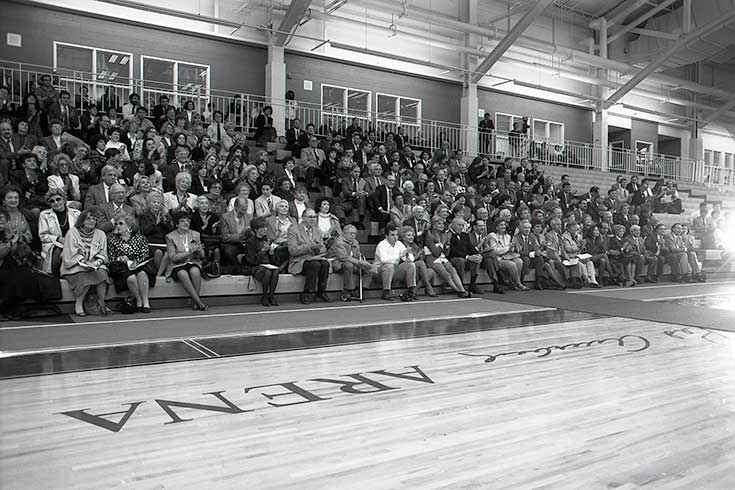

1993
- The Student Senate votes to recognize Queer Pride Week.
- Abram Sachar, H’68, the university's founding president, dies in July at age 94. The New York Times notes that, during his 20 years as president, Sachar raised $250 million for Brandeis and grew its campus "from a few buildings on the site of a bankrupt medical school to a complex of 90 buildings on 235 acres."
- After 23 years on the run, Katherine Power ’71, a former antiwar radical wanted by the FBI, surrenders to authorities in Boston.
- In December, The Justice publishes a paid advertisement that denies key facts about the Holocaust. More than 200 members of the Brandeis community gather outside Usdan in protest, arguing the ad amounts to libel. In the paper's next issue, Justice editors deride the ad as "trash" but defend the decision to run it, writing they did so to expose "these disgusting views to the Brandeis and Jewish communities."a
1994

- Smoking is prohibited in all nonresidential buildings. Although students protest, calling for smoking sections in lieu of a ban, the decision holds, and the ban is eventually extended to all of campus.
- The Playboy Foundation donates funds for 24 condom machines, which are installed in residence halls.
- The Graduate School of International Economics and Finance is established. In 2003, it changes its name to Brandeis International Business School.
- The Volen National Center for Complex Systems, which studies the brain and intelligence, is launched.
- The Shapiro Admissions Center opens.
- Samuel O. Thier, H’94, leaves the Brandeis presidency to become president of Massachusetts General Hospital. Jehuda Reinharz, GSAS PhD’72, H’11, takes over as the university's seventh president, the first alum to lead the institution. Previously, Reinharz served at Brandeis as provost, professor of modern Jewish history, and director of the Tauber Institute.
1995

- Nelson Figueroa ’98, a pitcher on the Brandeis baseball team, is drafted by the New York Mets following his junior season. He makes his Major League debut for the Arizona Diamondbacks in 2000.
- Israeli Prime Minister Yitzhak Rabin, who is slated to speak at Brandeis on Nov. 15, is assassinated on Nov. 4.
1996

- Film director Steven Spielberg, H’86, donates $1.6 million to create the Genesis Program, a Jewish-learning summer program for exceptional high school students.
- Guster performs in the Levin Ballroom.
- Thanks to the efforts of the Brandeis University National Women's Committee, now known as the Brandeis National Committee, the Brandeis Libraries acquire their 1 millionth volume, an edition of the Leeser Bible, the first American Jewish translation of the Hebrew Bible.
1997

- Feminist/author Gloria Steinem speaks in the Levin Ballroom, part of the celebration of a $1 million fundraising campaign benefiting the Brandeis women's studies program.
- The university's first-ever celebration of National Hispanic Heritage Month is organized.
- Eileen McNamara, who joined the Brandeis journalism department as an adjunct member in 1995, is awarded the Pulitzer Prize in Commentary for her columns in The Boston Globe. She begins teaching at the university full time in 2007.
- The Hadassah-Brandeis Institute is founded to encourage research on the fight for women's rights within different legal, religious, and cultural systems.
1998
- Law professor/author Anita Hill joins the Brandeis faculty. Today, she is University Professor of Social Policy; Law; and Women's, Gender, and Sexuality Studies.
- The university celebrates its first LGBTQ Pride Month.
- The International Center for Ethics, Justice, and Public Life is founded.
- The Center for German and European Studies opens, with then chancellor of Germany Helmut Kohl attending the dedication.
- Bernadette Brooten, now the Kraft-Hiatt Professor of Christian Studies, Emerita, earns a MacArthur Fellowship.
1999

- Ha Jin, GSAS MA’89, PhD’93, H’05, professor of English at Boston University, wins the National Book Award for Fiction for his novel "Waiting."
2000

- To make way for the construction of the Shapiro Campus Center, Ford Hall — the site of a pivotal 1969 occupation organized by Black student protesters and allies — is demolished.
- Biology professor Gina Turrigiano, the Joseph Levitan Professor of Vision Science, earns a MacArthur Fellowship.
2001

- The Women's Studies Research Center opens its doors.
- The Rose Art Museum completes construction of the Lois Foster Wing, a 8,800-square-foot addition that includes a dramatic two-story exhibition space.
2002

- The state-of-the-art Carl and Ruth Shapiro Campus Center opens, thanks to a $25 million gift from the Shapiros, who donate more than $72 million to transform the Brandeis campus.
- The Jack, Joseph, and Morton Mandel Center for Studies in Jewish Education is founded.
- The Florence Heller School for Advanced Studies in Social Welfare is renamed the Heller School for Social Policy and Management.
- In October, LGBTQ students display a giant condom in the Shapiro Campus Center as part of Coming Out Week. At the request of the president's office (in part because of a scheduled Board of Trustees meeting), the display is moved to Usdan.
2003

- The Brandeis-Wellesley Orchestra is founded, combining the longstanding orchestras at Brandeis and Wellesley College.
- Music UnitesUS, a program that sponsors intercultural residencies and concerts, is founded by Lydian String Quartet violinist Judith Eissenberg.
- Roderick MacKinnon ’78, H’05, wins the Nobel Prize in Chemistry, the first Brandeis graduate to earn a Nobel.
- The Lemberg Academic Center is completed, creating a state-of-the-art home for the Graduate School of International Economics and Finance.
- The Village residence hall is constructed.
- Historian David Hackett Fischer is named a University Professor.
- The Graduate School of International Economics and Finance is renamed Brandeis International Business School, emphasizing its global approach.
2004
- In January, the university welcomes its first-ever class of midyear students.
2005

- David Hackett Fischer, University Professor and the Earl Warren Professor of History, Emeritus, wins the Pulitzer Prize in History for his book "Washington's Crossing."
- Benny Friedman, Brandeis director of athletics from 1949-63 and football coach from 1950-59, is inducted into the Pro Football Hall of Fame. Friedman played in the NFL as a quarterback for the Cleveland Bulldogs, the Detroit Wolverines, the New York Giants, and the Brooklyn Dodgers.
- In January, several editors leave The Justice and form a second campus newspaper, The Hoot.
- The Crown Center for Middle East Studies is established to help make decision- and opinion-makers better informed about the Middle East region. Its approach is multidisciplinary, encompassing politics, economics, history, security, sociology, and anthropology.
- The Rabb School of Summer, Special, and Continuing Studies changes its name to the Rabb School of Continuing Studies.
- A new soccer field and track complex, which includes lights for nighttime contests, opens.
- Biochemistry professor Dorothee Kern is named a Howard Hughes Medical Institute Investigator.
2006

- In April, at the urging of LGBTQ students, President Jehuda Reinharz, GSAS PhD’72, H’11, signs a new nondiscrimination statement that prohibits discrimination related to "gender identity and expression."
- Yehudi Wyner, professor emeritus of composition, wins the Pulitzer Prize in Music for his piano concerto "Chiavi in Mano." The work was commissioned and premiered by the Boston Symphony Orchestra in 2005.
- Geir Haarde ’73, who attended Brandeis on a Wien Scholarship, becomes prime minister of Iceland.
- The Irving Schneider and Family Building, one of two buildings housing the Heller School, opens thanks to a $15 million gift.
- Irving R. Epstein, the Henry F. Fischbach Professor of Chemistry, is named a Howard Hughes Medical Institute Professor.
- David Oshinsky, GSAS PhD’71, is awarded a Pulitzer Prize in History for his book "Polio: An American Story." This marks the beginning of a Pulitzer Prize winning spree, spanning a dozen years, for Brandeis-educated historians: Alan Taylor, GSAS PhD’86, wins in 2014 for "The Internal Enemy: Slavery and War in Virginia, 1772-1832" (his second Pulitzer); David Kertzer, GSAS PhD’74, wins in 2015 for "The Pope and Mussolini"; and Jack E. Davis, GSAS PhD’94, wins in 2018 for "The Gulf: The Making of an American Sea."
2007

- In January, former President Jimmy Carter visits Brandeis. Though the visit is controversial due to comments in — and the title of — his latest book, "Palestine: Peace Not Apartheid," Carter is warmly welcomed by more than 1,700 students, faculty, and staff. "Except for an invitation from the U.S. Congress to deliver my inaugural address […], this is the most exciting invitation I've ever received. And it's gotten almost as much publicity," Carter says in his opening remarks.
- Former President Bill Clinton speaks on campus to inaugurate the Eli J. Segal Citizen Leadership Program. Eli Segal ’64 served as an assistant to the president during Clinton's years in the White House.
- The Schusterman Center for Israel Studies is founded.
2008

- Real estate developer Donald Soffer ’54, H’23, makes the largest-ever single gift to the university from an alum: $15 million, given to support the sciences at Brandeis.
- After first competing in the Athens Olympics in 2004, fencer Tim Morehouse ’00 brings home a silver medal from the Beijing Olympics.
- On the heels of their $25 million gift to support the building of the campus center, the Carl and Ruth Shapiro family pledges $14 million for a new admissions center.
- In September, the Materials Research Science and Engineering Center launches after receiving a highly competitive $7.8 million grant from the National Science Foundation. Combining study in the fields of materials science and biology, the center studies the properties of materials occurring in biological systems.
2009

- The university celebrates the opening of the Shapiro Science Center, a $154 million, 175,000-square-foot facility, which serves as a cornerstone to the renewal and expansion of the sciences at Brandeis.
2010
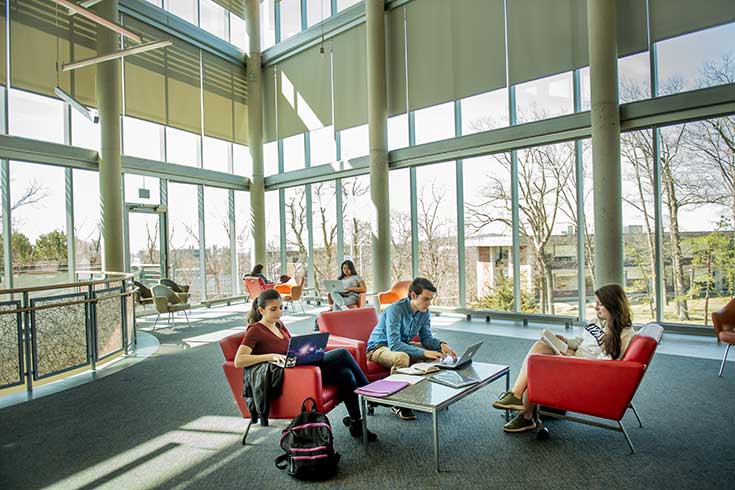
- Jehuda Reinharz, GSAS PhD’72, H’11, leaves the Brandeis presidency, returning to the Near Eastern and Judaic studies faculty and the directorship of the Tauber Institute for the Study of European Jewry, and becoming president of the philanthropic Mandel Foundation.
- The Justice Brandeis Semester, a summer program offering students the opportunity for immersive experiential learning, debuts.
- The new Mandel Center for the Humanities, made possible by a $22.5 million grant from the Mandel Foundation, is dedicated. The new building brings the university's humanities departments together under one roof, enhancing interdisciplinary collaboration.
- The university offers gender-neutral housing for the first time.
2011

- Frederick M. Lawrence, dean of the George Washington University Law School, becomes the eighth president of Brandeis.
- The BOLD (Brandeisians of the Last Decade) program is established to strengthen young alumni's engagement with the university.
- A minor in sexuality and queer studies is approved.
2012

- DEIS Impact, an annual week of programming that highlights the Brandeis community's commitment to social justice, is introduced.
- Michael Rosbash, the Peter Gruber Endowed Chair in Neuroscience, and Jeffrey C. Hall, professor emeritus of biology, win the Canada Gairdner International Award for their groundbreaking research on circadian rhythms.
- Brandeis holds its first Lavender Graduation to celebrate graduating LGBTQ students.
2013

- The Transitional Year Program, rooted in Brandeis' commitment to building diversity, equity, and inclusion, designed to prepare high-achieving students for a rigorous four-year undergraduate experience, is renamed in honor of Myra Kraft ’64, H’12.
- Kendrick Lamar, wearing a Brandeis sweatshirt, headlines the student-organized Springfest, part of the Leonard Bernstein Festival of the Creative Arts.
2014
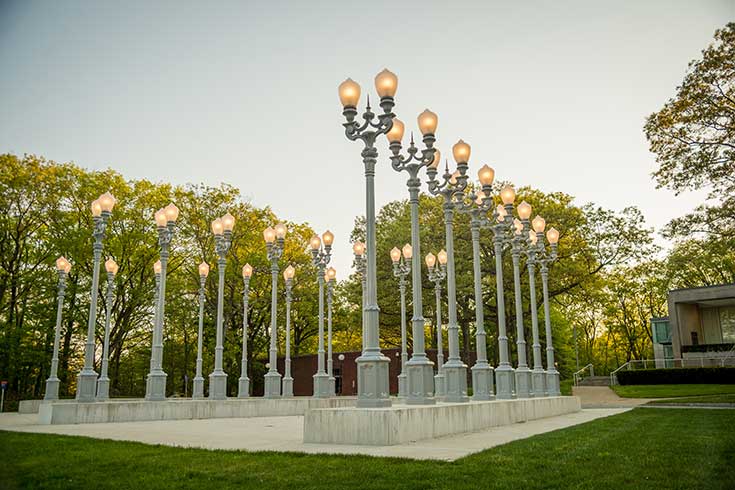
- Chris Burden's Light of Reason sculpture — the artist's last completed work — is installed in front of the Rose Art Museum. The name is inspired by a Louis Brandeis quote: "If we would guide by the light of reason, we must let our minds be bold." In an annual tradition, first-years gather at the sculpture during Orientation for an illumination ceremony.
- Brandeis International Business School announces the creation of the Hassenfeld Family Innovation Center, which fosters connections between academia and industry, and expands educational opportunities for students.
- The Gender and Sexuality Center, a home base for queer groups on campus, opens.
- Jané Kondev, the William R. Kenan Jr. Professor of Physics, is named a Howard Hughes Medical Institute Professor.
- Through a grant from the Hugh M. Hefner Foundation, Brandeis acquires the personal papers of comedy icon Lenny Bruce (1925-66) — including correspondence, photographs, transcripts, and audio recordings — from Bruce's daughter, Kitty.
2015

- Yehudi Wyner, professor emeritus of composition, is elected president of the American Academy of Arts and Letters.
- The SPARK initiative, which funds innovative projects that have a positive social, educational, or financial impact on a broad range of issues, is established at Brandeis.
- Frederick M. Lawrence leaves the Brandeis presidency and becomes a Distinguished Research Scholar at Yale Law School. Provost Lisa M. Lynch, H’17, a world-renowned economist, is named interim president.
- Anita Hill, professor of social policy; law; and women's, gender, and sexuality studies, is named a University Professor.
- The archives of Lilith magazine are donated to Brandeis, thanks to the magazine's founding editor Susan Weidman Schneider ’65 and a gift from Elaine Reuben ’63. The acquisition provides a cornerstone for the university's collections in Jewish feminism.
- The Princeton Review rates Brandeis No. 1 for student engagement in community service among 380 U.S. colleges and universities in the first year of the category's existence.
2016

- Ronald D. Liebowitz, formerly the president of Middlebury College, takes office as the ninth Brandeis president.
- "Louis D. Brandeis 100: Then and Now," a semester-long series of university events commemorating the centenary of the justice's appointment to the Supreme Court, is held. To kick off the celebration, Justice Ruth Bader Ginsburg, H’96, visits campus, speaking about the life and legacy of Justice Brandeis.
- Actress Kerry Washington and Anita Hill (whom Washington plays in the HBO film "Confirmation") meet for a conversation before a live audience at the Wasserman Cinematheque.
- The men's and women's soccer teams make Brandeis history as they both reach the NCAA DIII Final Four in the same season. It is the women's team's Final Four debut and the men's team's first Final Four appearance since 1984.
- Eve Marder ’69, the Victor and Gwendolyn Beinfield Professor of Biology, is awarded the Kavli Prize in Neuroscience for the discovery of mechanisms that allow experience and neural activity to remodel brain function.
2017

- The first drone footage of campus is shot.
- Philanthropists Rosaline and Marcia Cohn make a $50 million gift — the largest single gift in the university's history — to support student financial aid.
- Jonathan D. Sarna ’75, GSAS MA’75, the Joseph H. and Belle R. Braun Professor of American Jewish History, is named a University Professor.
- Michael Rosbash, the Peter Gruber Endowed Chair in Neuroscience, and Jeffrey C. Hall, professor emeritus of biology, win the Nobel Prize in Physiology or Medicine. Studying the fruit fly, the pair discovered the molecular mechanisms controlling circadian rhythms, the biological clock that regulates almost all life on Earth.
- In the wake of the #MeToo movement, Anita Hill is chosen to lead a newly formed Hollywood commission on sexual harassment.
2018

- The sustainable, energy-efficient Skyline Residence Hall opens.
- Irving R. Epstein, the Henry F. Fischbach Professor of Chemistry, and Eve Marder ’69, the Victor and Gwendolyn Beinfield Professor of Biology, are named University Professors.
- Brandeis celebrates the centennial of the birth of composer/conductor Leonard Bernstein, H’59, who taught at Brandeis from 1951-56. Events include an exhibition organized by the Museum of American Jewish History; selections from Bernstein's opera "Trouble in Tahiti," performed by the Boston Lyric Opera; and a concert version of Bernstein's "Mass," performed by the Brandeis University Chorus and guest artists.
2019

- Astrophysics professor John Wardle is part of a team of 200 scientists around the globe who capture the first-ever image of a black hole.
- The journal Nature ranks Brandeis fifth among institutions with the highest output of top-quality research in the natural sciences.
- The first-of-its-kind Queer Academics and Activism precollege program brings high school students to campus to study the LGBTQ+ experience in America.
- The university revises its nondiscrimination policy to prohibit discrimination related to caste.
2020

- On March 16, Brandeis sends the campus community home in response to the rapid spread of COVID-19.
- Anita Hill is named one of Time magazine's 100 Women of the Year for her pioneering activism in the areas of equality and women's rights. Hill is listed as the honoree for 1991, the year she testified before the U.S. Senate during hearings on Clarence Thomas' nomination to the Supreme Court. Other Brandeisians who make the list are Angela Davis ’65 (for 1971) and Eleanor Roosevelt, H’54 (for 1948).
- In May, for the first time in its history, Brandeis hosts an online-only Commencement ceremony.
- Brandeis welcomes students back to a COVID-ready campus at the end of August, with plexiglass barriers; a mask requirement; testing protocols; isolation housing; and an app for recording symptoms, receiving test results, and attesting to compliance with university COVID policies in place.
- A Shabbat-friendly daily health assessment is introduced to facilitate adherence to campus COVID-19 protocols. Users are able to report their health status without having to tear anything, write anything, or use an electronic device.
2021
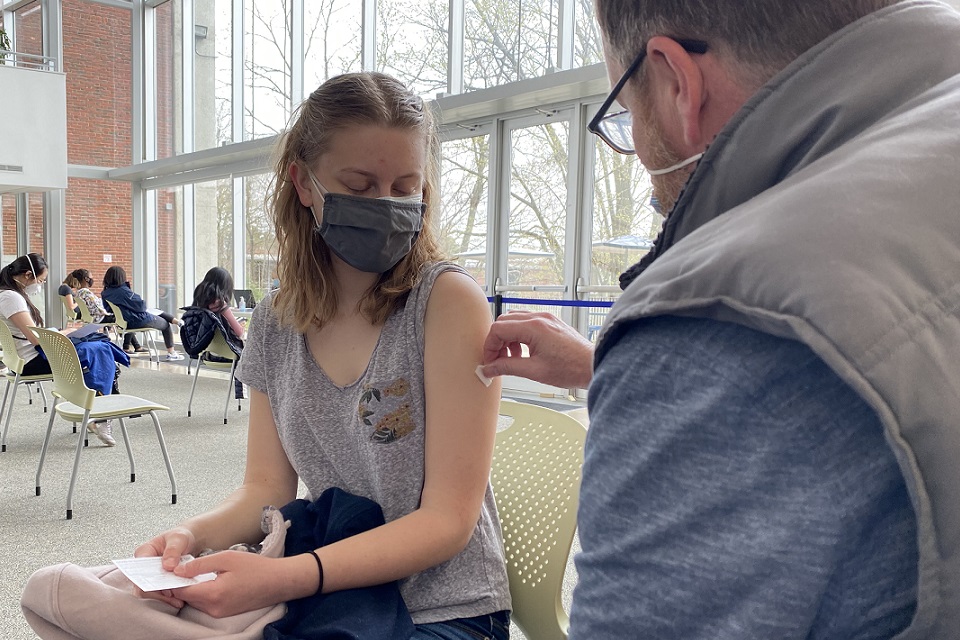
- Brandeis compiles its first BOLD 9 list of honorees. The annual list spotlights young alums making positive change around the world.
- In April, Brandeis becomes the first Massachusetts university to host COVID-19 vaccination clinics on campus.
- Brandeis officially celebrates the Juneteenth holiday for the first time.
- In December, Drew Weissman ’81, GSAS MA’81, P’15, H’23, is named one of Time magazine's Heroes of the Year for his foundational research leading to the development of the COVID-19 mRNA vaccines.
2022

- The Women's Power Gap Initiative and the American Association of University Women rank Brandeis No. 5 in the U.S. for the high percentage of women within its academic leadership.
- In response to the war and humanitarian crisis in Ukraine, Brandeis International Business School establishes a $1 million scholarship for refugees fleeing war-torn countries.
- In May, for the first time in three years because of COVID-19 concerns, Brandeis hosts in-person Commencement ceremonies, celebrating the Classes of 2020, 2021, and 2022.
- Brandeis receives five gifts totaling $16.5 million to endow five professorships in disciplines across the university. Three of the gifts come from alumnae.
2023

- National Science Foundation data shows Brandeis was ranked 17th in the U.S. in funding social sciences research in 2020-21, putting it alongside such research powerhouses as the University of Michigan, UC Berkeley, Harvard, and the University of Pennsylvania.
- The university announces a partnership with the Robert K. Kraft family and the Foundation to Combat Antisemitism to collaborate in the critical work of addressing hate against Jews and other communities.
- Deborah Lipstadt, GSAS MA’72, PhD’76, H’19, the U.S. Special Envoy to Monitor and Combat Antisemitism, is named one of Time magazine's 100 Most Influential People of 2023, for "battling the 'oldest hatred' at a moment when anti-Jewish hate has surged to record levels in the U.S. and around the world."
- In October, Drew Weissman ’81, GSAS MA’81, P’15, H’23, and his longtime collaborator Katalin Karikó, H’23, were awarded the Nobel Prize in Physiology or Medicine for their pioneering contributions to developing effective mRNA vaccines, used to stem the COVID-19 pandemic.
- Later that month — in a White House ceremony hosted by President Joe Biden — University Professor Eve Marder ’69, the Victor and Gwendolyn Beinfield Professor of Biology, and Greg Petsko, professor of biochemistry and chemistry, emeritus, each received a National Medal of Science, the highest recognition the U.S. bestows on scientists and engineers. Marder’s medal honored her theoretical and experimental approaches to understanding neural circuits. Petsko’s came for advancing knowledge around neurodegenerative diseases like ALS, Alzheimer’s, and Parkinson’s.
